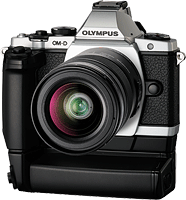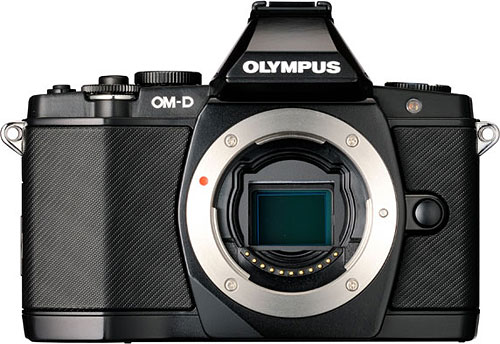| Back To News |
Source for Olympus E-M5 viewfinder revealed
posted Thursday, April 5, 2012 at 3:40 PM EST
 Last February, Olympus announced its first OM-D series Micro Four Thirds camera, the Olympus E-M5. Like the PEN-series cameras before it, the retro-styled Olympus M5 draws a parallel with an iconic product line from the company's history: the film-based OM-series cameras. Featuring what Olympus claimed to be the world's fastest autofocus system coupled to the world's first 5-axis image stabilization system, the E-M5 isn't just a pretty face. Perhaps the biggest differentiator from the company's PEN-series cameras, though, is its built-in electronic viewfinder.
Last February, Olympus announced its first OM-D series Micro Four Thirds camera, the Olympus E-M5. Like the PEN-series cameras before it, the retro-styled Olympus M5 draws a parallel with an iconic product line from the company's history: the film-based OM-series cameras. Featuring what Olympus claimed to be the world's fastest autofocus system coupled to the world's first 5-axis image stabilization system, the E-M5 isn't just a pretty face. Perhaps the biggest differentiator from the company's PEN-series cameras, though, is its built-in electronic viewfinder.
Now, thanks to a press release issued in Tokyo a few days ago, we know the source of that electronic viewfinder.
|
Epson's ULTIMICRON electronic viewfinder is used in the Olympus OM-D E-M5. Photo provided by Seiko Epson Corp. |
According to the release from Seiko Epson Corp., the Olympus OM-D E-M5 is based around an Epson Ultimicron LCD electronic viewfinder panel. First announced way back in October 2009, the panel in question is a high-temperature polysilicon, thin film transistor type. (Compared to the low-temperature polysilicon LCD displays typically used in cameras and smartphones, HTPS displays are typically more expensive, since they require a substrate with a higher melting point, such as optical quartz.) The panel has a high resolution of 1.44 million dots, equating to an 800 x 600 pixel (SVGA) array, with each pixel comprised of separate red, green, and blue dots. Unlike the ferroelectric displays used in some competing viewfinder designs, all colors are shown simultaneously, preventing the shimmering, 'rainbow' effect of time-multiplexed displays, which show each color sequentially.
So, it seems impressive on paper, but how does the display perform in the real world? Well, we're reserving judgement until we see a production of the E-M5 before, but hope to have one soon. Keep an eye on our Olympus E-M5 preview for more on this; in the meantime, further details can be found in the Seiko Epson press release below.
|
Olympus' E-M5 compact system camera. Photo provided by Olympus. |
Press Release
Epson Ultimicron Equipped as Standard in New Olympus OM-D Micro Four Thirds Camera
-Electronic viewfinder boasts 1.44-million dot resolution-
- TOKYO, Japan, March 29, 2012 - Seiko Epson Corporation ("Epson," TSE: 6724) today announced that its Ultimicron electronic viewfinder technology is equipped as standard in the Olympus OM-D Micro Four Thirds camera, scheduled to go on sale in spring 2012.
Based on a single Epson HTPS TFT color LCD panel, Ultimicron achieves superb full color images with supreme levels of detail and sharpness. Using Ultimicron, camera users can focus perfectly, and can reproduce rich color gradations and natural blurring when required. Using a color filter, Ultimicron also helps photographers shoot fast moving images without the color breakup*1 experienced using other formats.
The Ultimicron used in this highly evaluated camera is based on a 0.47 inch panel with SVGA (800 x RGB x 600), 1.44 million dot resolution, and achieves the clarity required by serious camera users. First launched in 2009, Ultimicron is based on the HTPS TFT LCD used in Epson's world leading projector range*2, and was created as a result of the company's many years of research as it sought to create the ultimate HTPS TFT LCD panel.
Epson will continue to refine its Ultimicron range as it seeks to meet growing demand among camera enthusiasts of all levels and abilities with superb quality electronic viewfinders.
*1 The phenomenon by which a transient image appears when photographers move the camera rapidly or shoot fast-moving subjects.
*2 According to Epson research (as of the end of March 2012)
Technology article: Ultimicron: The Ultimate LCD Panel
http://global.epson.com/newsroom/2012/news_20120306_2.html
Technology article: Epson Ultimicron series
http://global.epson.com/newsroom/2010/news_20100615.html
About Epson
Epson is a global imaging and innovation leader that is dedicated to exceeding the vision of customers worldwide through its compact, energy-saving, high-precision technologies, with a product line-up ranging from printers and 3LCD projectors for enterprise and the home, to sensors and other microdevices.
Led by the Japan-based Seiko Epson Corporation, the Epson Group comprises more than 78,000 employees in 99 companies around the world, and is proud of its ongoing contributions to the global environment and the communities in which it operates.
http://global.epson.com/
